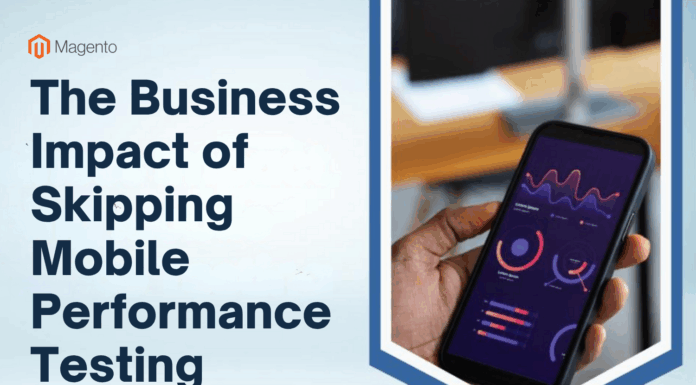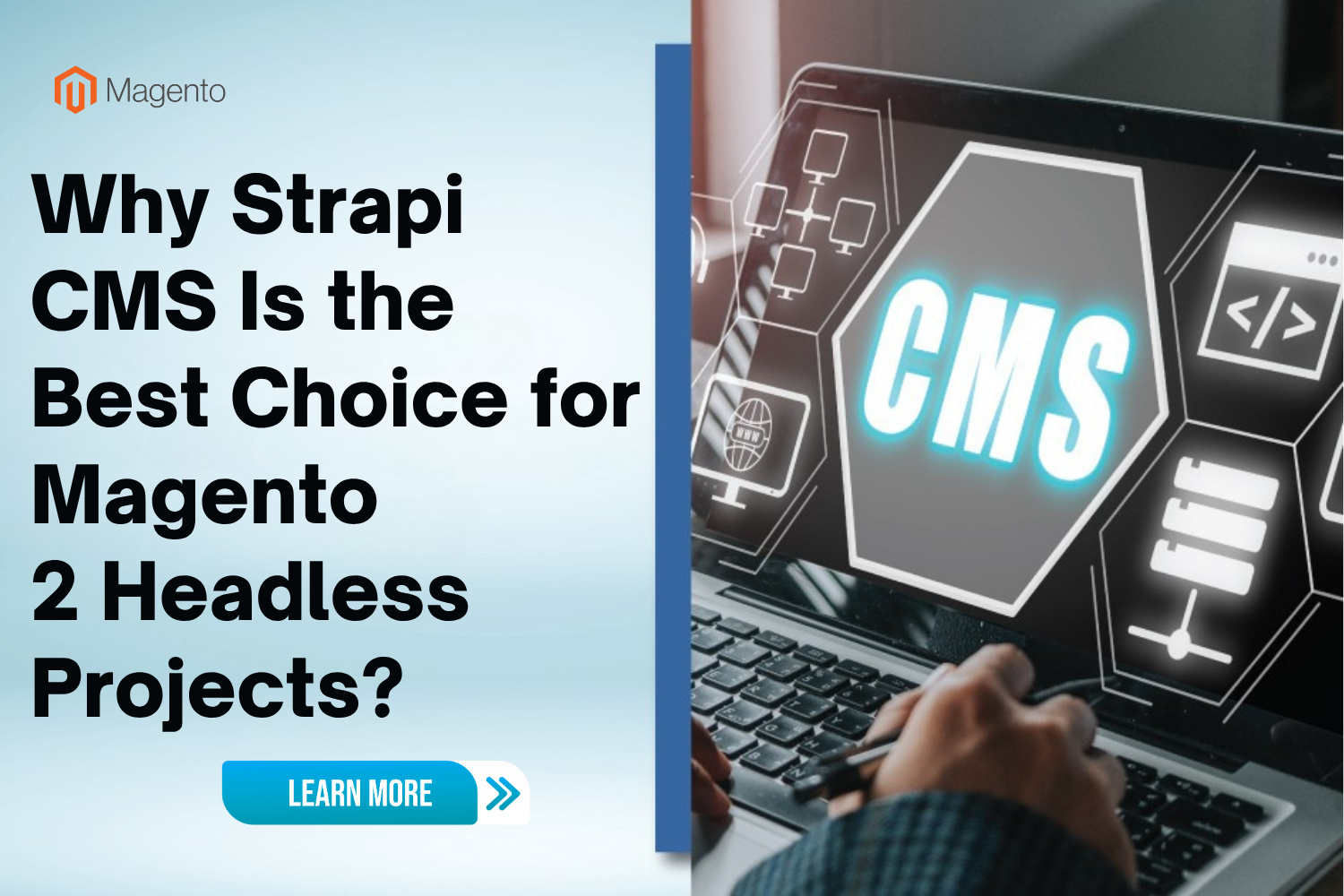
Strapi CMS for Magento 2 Headless Projects is transforming how e-commerce owners manage complex content workflows and omnichannel experiences. Being the e-commerce owner, you must have a full understanding that an effective workflow depends on how accurately data is managed. It can be quite tough when it comes to dealing with the increased complexity of product information. For every e-commerce owner, it’s complicated to balance evolving customer demands and increased sales channels.
Fortunately, CMS offers resources to assist in enhancing workflows. Headless CMS like Strapi for Magento offers e-commerce merchants a huge option to balance the complex content-driven workflows. As per the statistics, 79% of organizations utilize Strapi website development services, and they have witnessed a strong scalability, effectiveness & growth.
Collaborating Magento & Strapi means integrating the robust e-commerce potential with the flexible CMS! The integration follows the API-first approach. When Magento delivers the GraphQL API to embrace the full potential of e-commerce functionalities & Strapi offers RESTful & GraphQL APIs, it offers content.
Understanding the brief about the integration, assists in maximizing the efficiency of the setup. Nowadays, organizations adopt scalable & API-driven CMS to power websites & applications of the current age. Strapi, the popular headless CMS, receives appreciation since traditional CMS lack in meeting the objectives. To help you out, we have shared everything that you must know before hiring a Strapi development company.
Table of Contents
I. Understanding the Headless Commerce Model
What Is Headless Commerce?
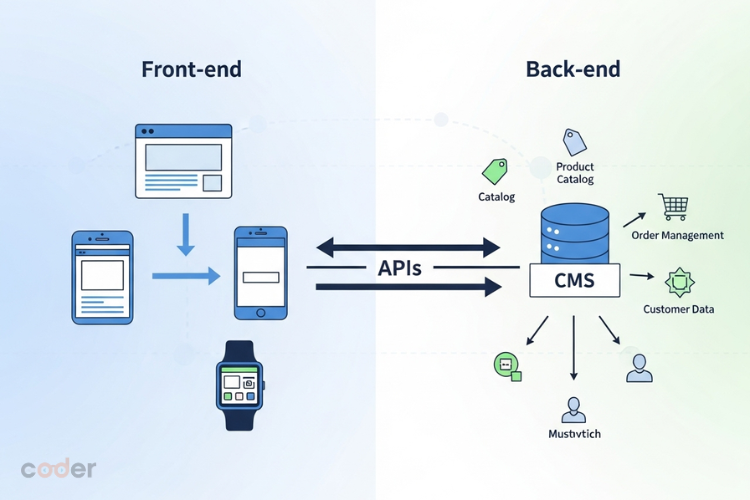
With the growing virtual economy, online retailers are smartly adopting evolving tech to thrive. Headless commerce technologies offer the flexibility & adaptability necessary to support the advanced customer journey. While traditional digital architecture struggles to adapt to the changing customer requirements, the headless commerce platforms are empowering merchants with a multichannel sales model.
It has accessibility to offer a personalized customer experience. The decoupling enables the organization to independently manage the front and back-end layers of CMS. The separation allows integration with the diverse digital touchpoints, guaranteeing a personalized & consistent user experience across every platform. Headless commerce gives potential to balance the system & customer-facing concerns separately, optimizing performance & flexibility.
The concept of headless commerce achieved appreciation in the early 2010s. Today, this Strapi website development services trend gives organizations the freedom to build faster & highly personalized purchasing experiences. It works best in both B2B & B2C business modules. Headless commerce allows organizations the flexibility to craft a faster, personalized experience without being limited by traditional platforms. When you integrate the best headless commerce architecture, it gives your organization greater control over the online store. It allows for maximizing the user engagement & drives rapid innovation.
II. Why Magento 2 Benefits from Going Headless?
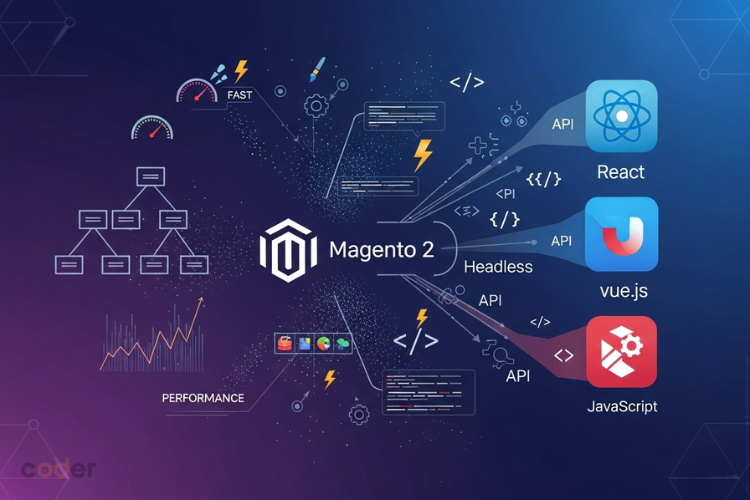
Removes front-end limitations of traditional Magento
When you move to headless architecture for your next Magento 2 projects, you directly separate the front-end & back-end. The Decoupling eliminates the front-end limitations of traditional architecture, giving great freedom to customize, innovate & offer superior performance. In a traditional Magento setup, the front & back ends are tightly linked.
Some common front-end traditional Magento limitations are performance overhead, design errors, and back-end dependency. In traditional architecture, making changes requires complicated adjustments to back-end code, which also slows down the development. The traditional architectures are designed primarily for web stores & don’t extend to new channels.
Supports React, Vue, and Next.js for modern storefronts
Magento 2 benefits from headless architecture through its support for modern front-end frameworks such as React and Vue. Magento 2 offers improved performance & user experience with extreme flexibility and customization. Decoupling the front-end from the back-end enables the utilization of modern, lightweight frameworks such as SSR. It results in faster page loading time & smoother user experience.
Headless Magento allows developers to overcome the constraints of traditional systems, enabling them to create custom & unique storefronts. A headless CMS setup offers a consistent user experience across various touchpoints, including web and mobile apps. Additionally, the decoupled architecture allows optimal performance and scalability. By choosing Strapi website development services, organizations can access the evolving ecosystem and design feature-rich storefronts.
Enhances performance and user experience
The speed at which marketing teams can modify the storefront in response to consumer trends or behavior is frequently constrained by traditional monolithic systems. Without depending on back-end modifications or development bottlenecks, headless commerce gives marketers complete creative power to introduce content-rich, customized experiences across channels. Strapi helps optimize performance, guaranteeing quick response times and effective resource use with functions like caching, crawling, and query optimization.
Makes integrations and content updates more agile
Moving Magento 2 to a headless architecture accelerates integration & content update by decoupling the front & back end. Magento can easily integrate with third-party tools, services & databases. It allows enterprises to craft a robust digital ecosystem. The communication between independent layers is managed by an API, which allows clients to get rid of the complicated structures of traditional platforms.
Content is stored in the central system & delivered through APIs. The team can easily push the updates to websites and mobile apps. The decoupled setup allows advanced customization & updates. It not only accelerates the ability to manage content but also enhances site performance, leading to faster load time.
III. Introducing Strapi CMS
1. What Is Strapi CMS?
Strapi is the free, self-hosted headless CMS that enables programmers to design & administer web & mobile apps. Strapi doesn’t specify how the front-end should be designed, in contrast to traditional CMS platforms. The Strapi system is customizable & approachable than a basic headless CMS. Strapi has the potential to enhance user interactions, since it has a friendly interface.
Additionally, the platform offers extensive customization & transparency. Strapi website development services support various technologies, including React, Mode.js, and ensure ease of integration & flexibility. It removes the hassle of selecting a CMS because of migration cost & fear of making the wrong selection.

Strapi offers fully managed services, which manage server management automatically, giving you more control. Its ease of creating and managing APIs is one of its best qualities. Data retrieval and modification are made simple by the ability to create RESTful and GraphQL APIs that reflect your content kinds. Because of this versatility, you may tailor API logic and endpoints to your requirements and make sure your mobile app has the precise data it needs.
2. Why Strapi Stands Out for Developers?
No vendor lock-in
Strapi website development services stand out as the key modules to prevent vendor lock-in through its open-source model. Strapi is a flexible, self-healing option. Vendor lock-in occurs when an organization is so dependent on a single provider’s tech that it becomes tough & costly to switch to another solution.
Strapi approaches allow programmers to have great assistance from developers over their content, codebases & infrastructure. Strapi ensures that a project’s long-term success isn’t reliant on a single vendor’s roadmap. The source code is available to developers so they can remove vendor lock-in, create exclusive features, and modify functionalities.
Easy integration with any tech stack
Strapi has the potential to seamlessly integrate with an array of front-end frameworks. By understanding the significance of React Vs Angular, you can select the front-end framework that matches your project without back-end limitations. Integration of Strapi with the frameworks offers flexibility in development.
It allows you to work with the familiar tools & speed up the development. Organizations can combine Strapi with effective frameworks for scalable apps. Design a personalized user experience with the flexible modeling of Strapi. Furthermore, it allows plugins, knowledge sharing, and accessibility to tools, thanks to its active community. Overall, the headless CMS’s compatibility with multiple frameworks assists in building powerful & user-friendly apps.
Supports both structured and dynamic content
Integrating Strapi into the tech stack centralizes CMS & makes it easy to oversee & organize information. Strapi offers an easy-to-access interface to organize content. Organizations can easily customize the content type to craft flexible content models that match enterprise needs. Furthermore, it aims to streamline the content creation & maintenance without excessive tech knowledge.
The Strapi website development services allow for crafting content once & reusing it all over the platforms to ensure consistency. Version control & role-based permission allow collaboration by allowing the team to manage changes, describe roles & connect with additional tools to enhance workflows.
Strapi allows you to deliver consistent and engaging content so that more and more users can visit your site. By integrating the module, the organization can simplify content creation and editing. Editors & marketers can update virtual touchpoints without relying on developers. For an organization leader, it benefits faster execution, a consistent user experience & empowered non-tech team.
IV. Key Reasons Why Strapi CMS Is the Best Fit for Magento 2 Headless Projects
1. Unified API Management
Magento 2 manages product data, orders & customer information. Strapi excels at balancing diverse content types such as blog posts, landing page content, and marketing materials. By integrating Strapi, businesses can centralize the management of all content through the centralized unified API layer.
2. Faster Front-end Development
Developers manage legacy software because of the effort and investment required in updating an app. Business fails to innovate in the marketplace. When integrating Strapi with Magento 2, businesses can design their own front-end design. Enterprises can future-proof their apps by separating the presentation layer from data. The programmers adopt the headless CMS approach to the section of the existing tech stack.
UX experts and designers can employ contemporary tools without the constraints of the past. Designers and UX experts have unrestricted freedom to express their creativity. In the end, using a headless CMS strategy guarantees the flexibility to use any future technology that makes sense at the time. You will be aware now that future modifications are possible without requiring a complete overhaul of your codebase.
3. Powerful Content Management
Instead of distributing the content on multiple platforms and integrating vast solutions to get the content published, businesses can balance all of them from a single location. Headless CMS assists you in doing that by turning the content into a unified format. Headless CMS supports businesses by making the content present in a universal format.
4. API-First Architecture
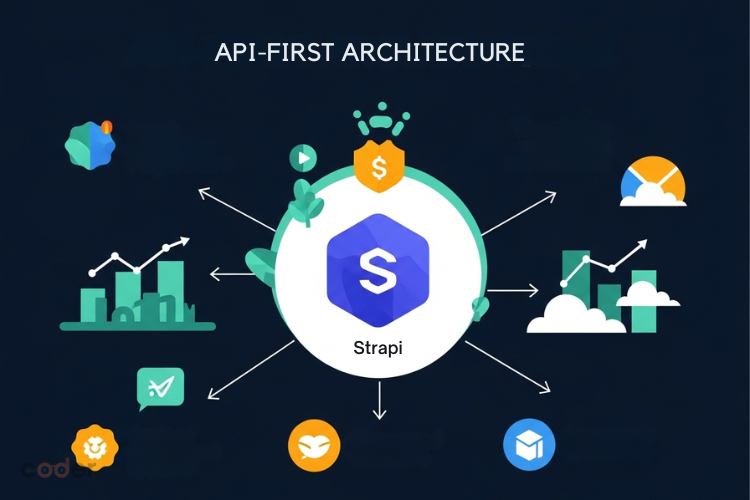
Strapi is designed with the API-first approach, automatically generating GraphQL and RESTful APIs based on the structure of content. It eliminates the requirement for manual back-end API development. It significantly streamlines the process of content usability. The solution offers frequent API development with the API-first approach, enabling faster project deployment.
5. Scalability for Growing Businesses
As your company expands, quickly scale your website with Strapi. Without interfering with current operations, the system allows for the addition of new features, content kinds, and integrations. This scalability guarantees that your website can accommodate growing traffic and content requirements.
6. Improved SEO and Performance
By using a headless CMS, you can set up your company to produce interesting content for all platforms, easily adopt new technologies, and develop as your needs dictate. To make your pages visible, use plugins. Within the CMS, you may control keywords, meta tags, etc. This feature increases the search engine exposure of your website, increasing organic traffic and possible leads.
7. Secure and Customizable Access Control
Custom solutions guarantee that your corporate website satisfies certain business requirements. You can design original content formats and types that support business goals. This adaptability makes your website unique by enabling a customized user experience. The Strapi framework places a high priority on security, which includes integrated authentication mechanisms.
8. Omnichannel Content Delivery
The headless architecture of Strapi allows content delivery across various platforms, including websites, mobile apps & wearable tech. Unlike traditional SMS platforms, Strapi delivers great flexibility in delivering a personalized user experience. For organizations targeting foreign countries with region-specific content or multilingual content, Strapi offers a powerful CMS. Now, businesses can easily achieve seamless integration across multiple digital touchpoints, further driving customer engagement & accessibility.
9. Open-Source Flexibility
Partnering with the Strapi website development company enables enterprises to benefit from a custom configuration of the admin panel to fit the workflow. This model is highly advantageous for complex industries that need strong regulatory adherence.
10. Cost-Effective and Developer-Friendly
Strapi is a free CMS, so it saves organizations from paying a licensing fee. This cost-effective model minimizes the development type for business. It supports businesses to opt for a quick time-to-market.
V. How Strapi and Magento 2 Collaborate in a Headless Setup?
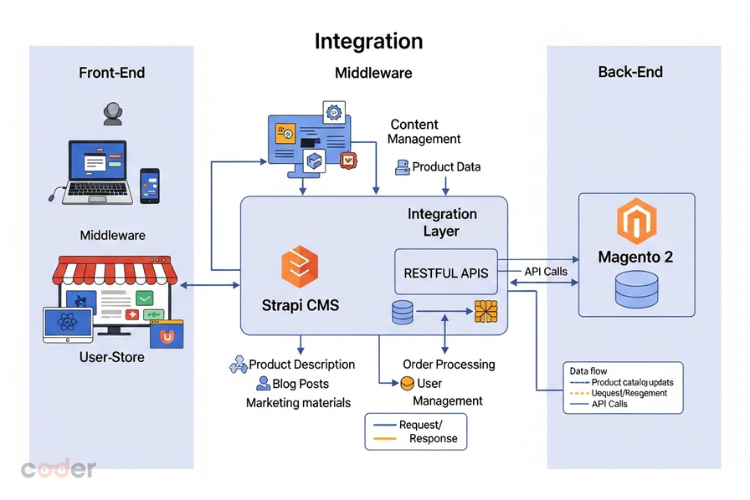
Integration Flow
By combining Strapi with Magento 2 in a headless configuration, you can use Strapi’s adaptable CMS with Magento’s powerful e-commerce features to build unique, content-rich shops. Both platforms’ API-first strategies, which allow them to connect via REST or GraphQL APIs, constitute the basis of the integration.
By enabling exact data fetching, which boosts performance and lowers data transmission, a Strapi GraphQL setup can increase the efficiency of API integration. It facilitates CRUD processes and makes management easier, especially when working on complicated data structures. Their API-first strategy makes it easier to synchronize product and content data, guaranteeing uniformity across all platforms and channels.
Example Architecture Overview
Front-end: A modern JavaScript framework such as Next.js, Nuxt.js, React, or Vue.js is used to create the user-facing portion of the application. This program is in charge of displaying a quick, highly personalized user interface.
Back-end: The primary e-commerce engine, Magento 2, is in charge of all transactional data. Product information retrieval, cart management, order processing, and customer account management are all made possible by its APIs.
Middleware: While Magento 2’s GraphQL API manages e-commerce features, Strapi, a headless CMS, offers a GraphQL or REST API for content. The middleware is a method for a central layer to effectively collect and serve this data rather than a single product.
VI. Real-World Benefits for Businesses
Reduced Development Time
By avoiding the intricacies of Magento’s conventional monolithic structure, the modular design facilitates speedier iterations, prototyping, and delivery times.
Enhanced User Experience & SEO Performance
In this configuration, Strapi offers a versatile, API-driven content management layer, while Magento 2 acts as the powerful e-commerce engine, managing product catalogues and transactions. Because Strapi is lightweight, pages load more quickly, accelerating customer experience & great SERP.
Simplified Personalization & Campaign Control
This effective combo makes use of Strapi as a versatile, API-driven CMS and Magento 2 for its strong e-commerce features. When combined, they enable marketing teams to produce customized, multi-channel experiences without the need for coders.
Future-Ready Scalability
Businesses may create highly scalable, adaptable, and future-proof e-commerce architecture by utilizing Strapi with Magento 2. Front-end and back-end components can scale independently thanks to the headless setup. It makes it possible to grow and adapt to new digital channels more effectively.
VII. Potential Challenges and Best Practices
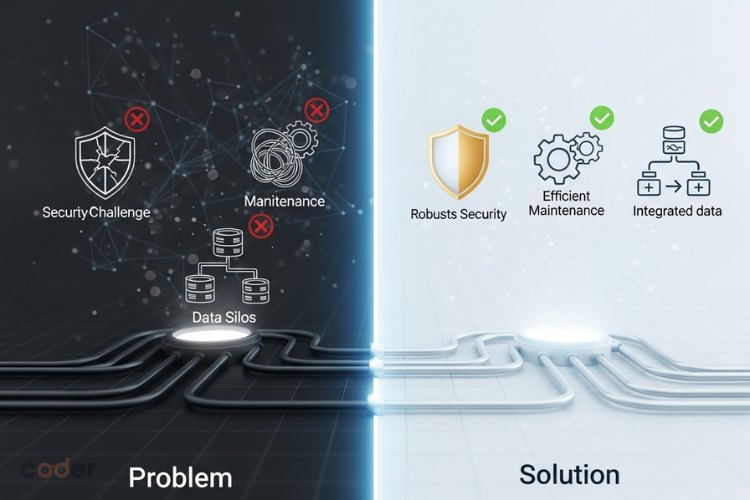
Integration Complexity
Data silos, compatibility problems, security threats, and cost overruns are some of the difficulties associated with integration complexity that can cause operational problems and delays in projects. Standardizing data formats, taking a staged approach, and putting strong security measures in place are some best practices for handling this.
Security and Maintenance
The quick evolution of cyber-attacks and the growing complexity of IT environments are major security and maintenance issues. To quickly install security patches to operating systems, implement a strict patch management procedure by collaborating with the Strapi development company.
Workflow Management
The practice of planning, recording, and streamlining a sequence of actions to achieve a certain business objective is known as workflow management. Implementing these procedures can be difficult, but you can implement an array of practices to get help.
VIII. Ready to Go Headless? Let’s Power Your Magento 2 Store with Strapi Today
When you integrate Strapi website development services with Magento 2, you are going to emphasize the future-proofing and advanced headless projects. By concluding the above content, you have an idea of why Strapi is more beneficial than any other CMS options. If you want to make a seamless integration of Strapi-Magento 2, hire a Strapi website development company today.







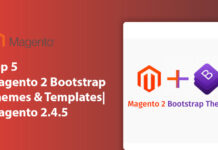



![[SALE OFF] Discount 30% All Premium Extensions On Christmas And New Year 2025 christmas-and-new-year-2025](https://landofcoder.b-cdn.net/wp-content/uploads/2024/12/christmas-and-new-year-2025-1-218x150.png)





